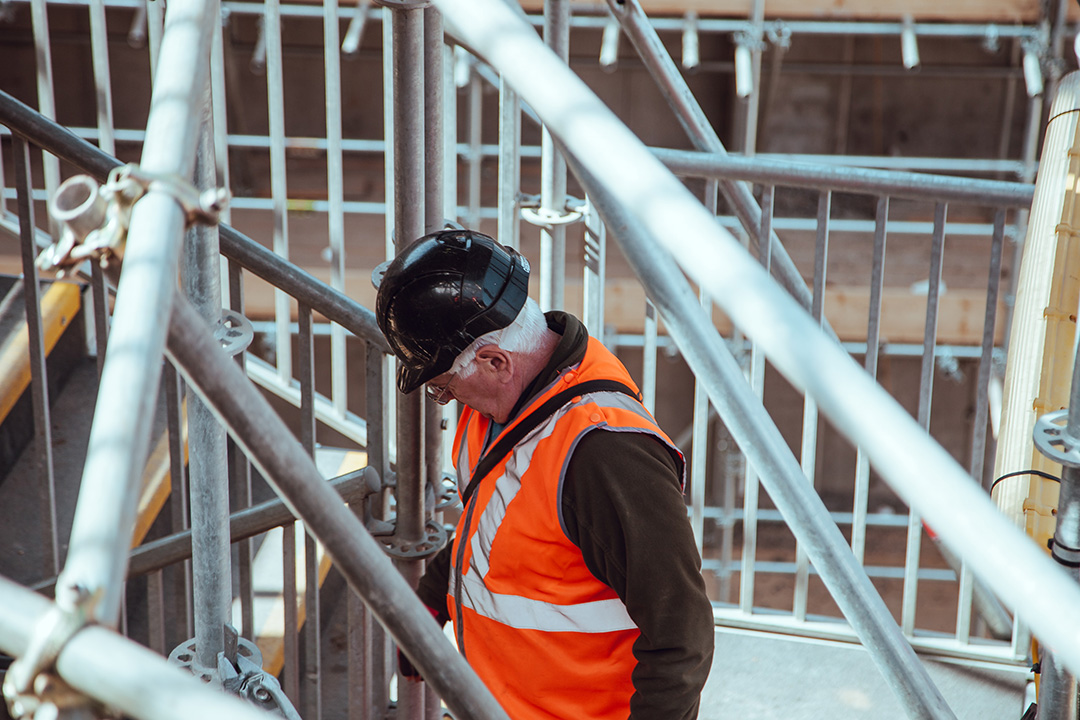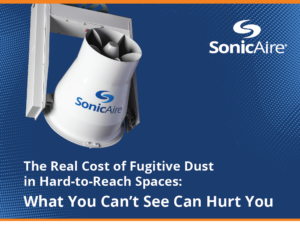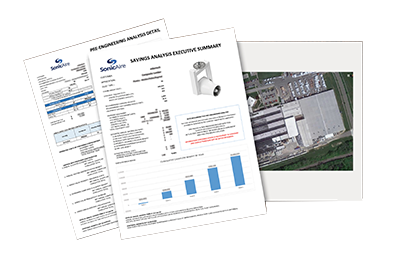A Citation Isn’t the End of the Road
Getting an OSHA citation for dust buildup can feel overwhelming. But you’re not alone, and it’s not the end of the road. At SonicAire, we help facilities like yours turn that warning into a wake-up call for lasting change. Here’s what you need to know and how you can take back control.

Understanding the Real Risk: Combustible Dust
Dust may seem harmless, but in the right conditions, it becomes fuel. Just 1/32 of an inch of dust, about the thickness of a paperclip, is enough to trigger a fire or explosion. The real danger? Not the first explosion. It’s the second one.
When dust ignites, the pressure can knock more dust into the air, creating a powerful secondary explosion. This is called deflagration. That’s when real damage happens. Facilities can suffer severe structural damage, worker injuries, and production losses. Even worse, these events can travel fast (we’re talking milliseconds here) through facilities, spreading danger far beyond the ignition point.
That’s why OSHA and the NFPA take combustible dust so seriously. And it’s why staying ahead of dust buildup is so important.
Common OSHA Violations Related to Combustible Dust
OSHA citations related to dust hazards often include:
- Not having a dust control plan (DHA- Dust Hazards Analysis) in place
- Letting dust build up on rafters, ducts, electrical trays, and overhead areas
- Using the wrong electrical equipment in dusty environments
- Not training employees on combustible dust risks
Each of these can lead to fines, but more importantly, they increase the chance of a dust-related incident.
What to Do After an OSHA Citation
Here are your next steps if you’ve received a citation:
- Fix the issue quickly: Correct the hazard within the deadline OSHA gives you
- Document everything: Show what steps you’ve taken to solve the issue
- Prepare for follow-up: OSHA may inspect your facility again
- Take it further: Put long-term systems in place to prevent future issues
The High Cost of Inaction
The true cost of a citation isn’t just the fine. You may face downtime, insurance hikes, lost productivity, and even lawsuits. A single combustible dust event can shut down operations, injure workers, and damage your reputation.
And the cleanup costs after an explosion or fire can reach hundreds of thousands of dollars. Some companies never recover. That is why investing in proactive dust control is not just smart. It is necessary.
SonicAire: Your Partner in Prevention
SonicAire helps you prevent citations before they happen. Our engineered dust control systems are designed specifically for overhead and hard-to-reach areas where dust tends to accumulate. Here’s how we help:
Prevent Overhead Dust- Our BarrierAire technology creates an invisible shield of air that keeps dust from settling overhead. Instead, the dust falls to the floor, where it can be safely removed with routine cleaning. This simple shift in airflow makes all the difference.
Improve Workplace Safety – Say goodbye to risky manual cleaning. With SonicAire fans, your team doesn’t need to climb into rafters or shut down lines to clean. That means fewer injuries and more uptime. Your employees stay safe, and your facility keeps running.
Stay Compliant – SonicAire’s system is recognized by NFPA 660 as a compliant method for dust control. Our fans help you meet OSHA regulations and NFPA guidelines with confidence- if a guarantee of compliance doesn’t do it, we don’t know what will. With the only proactive dust control system in place, you can relax. You don’t have to worry about surprise inspections, citations, and rising insurance premiums.
Save Time and Money- Facilities that use SonicAire Fan Systems often eliminate the need for expensive manual cleanings. That means lower costs, less downtime, and better productivity. The return on investment is clear. For many companies, the system pays for itself within a year.
Custom Solutions for Every Facility No two facilities are the same. That is why SonicAire engineers each dust control system specifically for your plant layout, your processes, and your dust type. Whether you operate in food processing, wood products, plastics, textiles, or other industries, we tailor the solution to fit your needs.
Customer Story: Watson Wood Works
Watson Wood Works was cited by OSHA for combustible dust buildup. After obtaining some quotes for outside vendors to clean, they decided to install SonicAire fans instead. This move gave them a savings of over $200,000 annually, and they haven’t looked back.
“SonicAire fans run without any issue, giving us peace of mind that employee safety is taken care of and the element of danger posed by combustible dust is mitigated in the most efficient way,” said Jesse Watson, President of Watson Wood Works. Watson estimates the maintenance and operation of the fans costs less than $1,000 per year.
Their team now spends less time cleaning and more time producing. And they have full confidence in their compliance.
You Can Take Control
You don’t have to live in fear of the next inspection. With SonicAire, you can stop dust buildup before it starts. Let us help you protect your people, your production, and your peace of mind.
Let us show you how easy it can be to stay safe and compliant. Visit www.sonicaire.com to schedule your free dust control consultation today.
Dust Hazard Analysis
A Dust Hazard Analysis (DHA) is a comprehensive evaluation designed to identify, assess, and mitigate risks associated with combustible dust in industrial facilities. According to NFPA 652, the requirement to conduct a Dust Hazard Analysis (DHA) for existing facilities became mandatory by September 7, 2020; this applies retroactively to all facilities with combustible dust hazards, meaning they needed to complete a DHA by that date if they hadn’t already done so. OSHA’s new National Emphasis Program has already begun to bring DHAs into the focus of facilities with combustible dust.
To learn more about Dust Hazard Analysis and why you need one, check out our YAWA, What’s a DHA and Why Does it Matter? or our blog, The Complete Guide to Dust Hazard Analysis (DHA) for Manufacturing Facilities.
Comprehensive Testing Services

GET YOUR FREE GUIDE:
The Real Cost of Fugitive Dust in Hard-to-Reach Spaces
What You Can’t See Can Hurt You
To help protect your workplace, we’ve compiled the following resource, The Real Cost of Fugitive Dust in Hard-to-Reach Spaces: What You Can’t See Can Hurt You. In it, we identify seven ways fugitive dust is likely impacting your facility and its profitability.
These costs go beyond housekeeping and explain why you should be preventing dust buildup to protect the bottom line, not just to stay in compliance.


